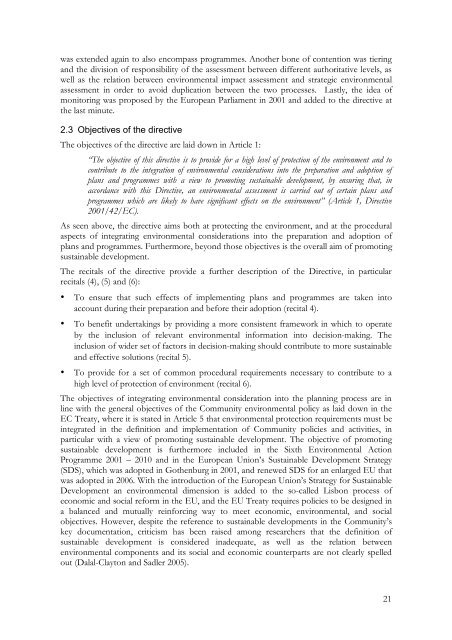SEA IN THE CONTEXT OF LANDTUSE PLANNING
SEA IN THE CONTEXT OF LANDTUSE PLANNING
SEA IN THE CONTEXT OF LANDTUSE PLANNING
You also want an ePaper? Increase the reach of your titles
YUMPU automatically turns print PDFs into web optimized ePapers that Google loves.
was extended again to also encompass programmes. Another bone of contention was tieringand the division of responsibility of the assessment between different authoritative levels, aswell as the relation between environmental impact assessment and strategic environmentalassessment in order to avoid duplication between the two processes. Lastly, the idea ofmonitoring was proposed by the European Parliament in 2001 and added to the directive atthe last minute.2.3 Objectives of the directiveThe objectives of the directive are laid down in Article 1:“The objective of this directive is to provide for a high level of protection of the environment and tocontribute to the integration of environmental considerations into the preparation and adoption ofplans and programmes with a view to promoting sustainable development, by ensuring that, inaccordance with this Directive, an environmental assessment is carried out of certain plans andprogrammes which are likely to have significant effects on the environment” (Article 1, Directive2001/42/EC).As seen above, the directive aims both at protecting the environment, and at the proceduralaspects of integrating environmental considerations into the preparation and adoption ofplans and programmes. Furthermore, beyond those objectives is the overall aim of promotingsustainable development.The recitals of the directive provide a further description of the Directive, in particularrecitals (4), (5) and (6):• To ensure that such effects of implementing plans and programmes are taken intoaccount during their preparation and before their adoption (recital 4).• To benefit undertakings by providing a more consistent framework in which to operateby the inclusion of relevant environmental information into decision-making. Theinclusion of wider set of factors in decision-making should contribute to more sustainableand effective solutions (recital 5).• To provide for a set of common procedural requirements necessary to contribute to ahigh level of protection of environment (recital 6).The objectives of integrating environmental consideration into the planning process are inline with the general objectives of the Community environmental policy as laid down in theEC Treaty, where it is stated in Article 5 that environmental protection requirements must beintegrated in the definition and implementation of Community policies and activities, inparticular with a view of promoting sustainable development. The objective of promotingsustainable development is furthermore included in the Sixth Environmental ActionProgramme 2001 – 2010 and in the European Union’s Sustainable Development Strategy(SDS), which was adopted in Gothenburg in 2001, and renewed SDS for an enlarged EU thatwas adopted in 2006. With the introduction of the European Union’s Strategy for SustainableDevelopment an environmental dimension is added to the so-called Lisbon process ofeconomic and social reform in the EU, and the EU Treaty requires policies to be designed ina balanced and mutually reinforcing way to meet economic, environmental, and socialobjectives. However, despite the reference to sustainable developments in the Community’skey documentation, criticism has been raised among researchers that the definition ofsustainable development is considered inadequate, as well as the relation betweenenvironmental components and its social and economic counterparts are not clearly spelledout (Dalal-Clayton and Sadler 2005).21
















